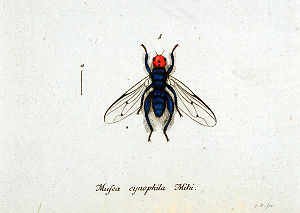Lentil fly
| Lentil fly | ||||||||||||
|---|---|---|---|---|---|---|---|---|---|---|---|---|

Dog fly (picture by Jacob Sturm ) |
||||||||||||
| Systematics | ||||||||||||
|
||||||||||||
| Scientific name of the genus | ||||||||||||
| Thyreophora | ||||||||||||
| Meigen , 1803 | ||||||||||||
| Scientific name of the species | ||||||||||||
| Thyreophora cynophila | ||||||||||||
| ( Panzer , 1798) |
The lens fly ( Thyreophora cynophila ), also known as the dog fly , is a type of fly from the cheese fly family (Piophilidae). It was believed to be extinct for 160 years before it was rediscovered in late 2009 ( Lazarus taxon ).
description
The lens fly reaches a size of approx. 10 mm. The large swollen head is bright orange-red and phosphorescent. The body is metallic blue. The wings each show two dark points.
Way of life
The lentil fly lives in dark places and was often found on the carcasses of large domestic and farm animals such as dogs, mules and horses in autumn .
Distribution and Status
Central Europe , especially Germany , France , Switzerland and Austria was originally assumed to be the main distribution area. Fifty years after it was described by the German entomologist Georg Panzer in 1798, the species was last sighted near Paris. Their disappearance was believed to have been due to changes in livestock husbandry and carcass disposal during the Industrial Revolution . At the end of 2009 an amateur photographer discovered an unknown species of fly in the Spanish national park “Sierra de Cebollera”, which he initially thought to be a tropical species. In August 2010, a Spanish team found more specimens in the same national park and confirmed the rediscovery of the lens fly.
literature
- Séguy, E. 1950. La biologie des diptères . Encyclopédie entomologique, Ser. A 26: 1-609. ISBN 2720503398 (French)
- Martín-Vega, D .; Baz, A. & Michelsen, V. 2010. Back from the dead: Thyreophora cynophila (Panzer, 1798) (Diptera: Piophilidae) 'globally extinct' fugitive in Spain. Systematic Entomology, doi : 10.1111 / j.1365-3113.2010.00541.x
- Miguel Carles-Tolrá, Pablo C. Rodríguez & Julio Verdú (2010). "Thyreophora cynophila (Panzer, 1794): collected in Spain 160 years after it was thought to be extinct (Diptera: Piophilidae: Thyreophorini)" (PDF; 246 kB). Boletín de la Sociedad Entomológica Aragonesa (SEA) 46: 1-7.
Web links
- 'Mythical' extinct fly rediscovered after 160 years BBC News post about the rediscovery of the dog fly
- Systematic Entomology Volume 35, Issue 4 Report on the discovery of 6 specimens from Spain (PDF, English)
- Fauna Europaea - Taxonomic Group: Diptera: Brachycera
- Proceedings of the First European Forensic Entomology Seminar (PDF, English; 1.3 MB)
- The Future of Entomological Collections (PDF, English; 1.25 MB)
- Illustration of the dog fly from Georg Panzer "Insects of Germany" (1888 edition)
- Description of the dog fly (in Latin) from Georg Panzer "Insects of Germany" (1888 edition)
- Movies on Youtube
Individual evidence
- ↑ 'Horrorfliege' sighted ( memento from September 25, 2010 in the Internet Archive ).